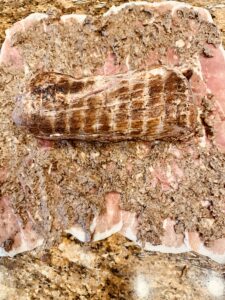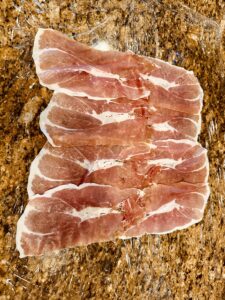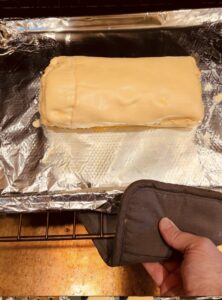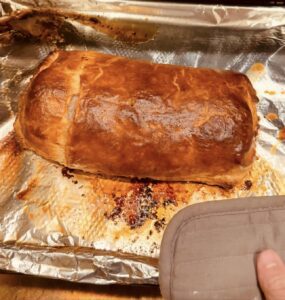Make a TV Chef Quality Dish for Your Special Occasion
Have you seen Chef Gordon Ramsay on Hell’s Kitchen? Beef Wellington is a classic dish that has been enjoyed by meat lovers for centuries. This decadent dish consists of a beef tenderloin that has been seared, coated in a layer of flavorful mushroom duxelles, wrapped in puff pastry, and baked to golden-brown perfection. While the dish may seem daunting to prepare, it is very manageable if you follow our recipe and technique in 7 simpler steps.
In this post, we will take a deep dive into the world of Beef Wellington, exploring its origins, the role of Chef Gordon Ramsay in popularizing the dish, and, most importantly, providing a step-by-step guide on how to make Beef Wellington in your own kitchen.
The Star of this Show is the Beef Tenderloin.
Beef tenderloin is a cut of beef from the loin area of the cow. It is one of the most tender and highly prized cuts of meat, which makes it a popular choice for upscale dishes like Beef Wellington. The tenderloin is a long, narrow muscle that runs along the spine of the cow, and it is located in the rear of the animal, just behind the sirloin. Because the tenderloin is not a weight-bearing muscle, it is very tender, with little fat or connective tissue. It is often sold as a whole roast, but it can also be cut into individual steaks, such as filet mignon.
Origins of Beef Wellington
The Role of Chef Gordon Ramsay in Popularizing Beef Wellington
While Beef Wellington has been around for centuries, it wasn’t until the early 2000s that it started to gain widespread popularity. This was largely due to the efforts of Chef Gordon Ramsay, who featured the dish on his hit TV show, “Hell’s Kitchen.”
Ramsay is widely credited with reviving interest in classic British cuisine, and his version of Beef Wellington has become one of his signature dishes. In his recipe, Ramsay adds a layer of prosciutto over the mushroom duxelles to add even more flavor to the dish.
How to Make Beef Wellington
Now that we’ve explored the history of Beef Wellington and the role of Chef Gordon Ramsay in popularizing the dish, it’s time to get down to the business of making it. Here’s a step-by-step guide to making the perfect Beef Wellington in your own kitchen.
Ingredients:
- 1 (2-pound) beef tenderloin, trimmed
- 2 tablespoons olive oil
- 1 teaspoon kosher salt
- 1/2 teaspoon black pepper
- 1/2 cup minced shallots (about 2 large)
- 8 ounces white button mushrooms, finely chopped
- 3 tablespoons unsalted butter
- 2 cloves garlic, minced
- 2 teaspoons chopped fresh thyme leaves
- 1/2 cup dry white wine
- 6 thin slices prosciutto
- 2 tablespoons Dijon mustard
- 1 (14-ounce) package puff pastry, thawed
- 1 large egg, lightly beaten
- Flaky sea salt, for serving
Directions:
Preheat the oven to 425 degrees F.
Step 1: Sear the Beef

In a large skillet, heat the olive oil over high heat. Season the beef tenderloin with kosher salt and black pepper, and sear it in the skillet until browned on all sides, including the ends, about 3-4 minutes per side. Wrap the beef in foil and refrigerate to cool completely. This could be done the night before.
Step 2: Make the Mushroom Duxelles
In the same skillet, add the minced shallots and chopped mushrooms, reducing to medium heat until the mixture has softened and any excess moisture has evaporated, about 8-10 minutes. Add the butter, garlic, and thyme to the skillet and cook for an additional minute. Pour in the white wine and cook until the liquid has evaporated, about 2-3 minutes.
Transfer the mushroom duxelles mixture to a bowl and refrigerate to cool completely.
Step 3: The Wrap 1 – Prosciutto Layer

Lay out a large piece(s) of plastic wrap on your work surface, and place the prosciutto slices on top, slightly overlapping each other. Spread the cooled mushroom duxelles mixture over the prosciutto, leaving a small border around the edges.
Spread the Dijon mustard all over the beef tenderloin, then place the beef on top of the mushroom mixture.
Grab the plastic wrap to roll the prosciutto and mushroom mixture around the beef, forming a tight log. Place the wrapped beef in the refrigerator and let it chill for at least 30 minutes.
Step 4: The Wrap 2 – Puff Pastry Layer
Here we go again! This time Lay out a

large piece(s) of plastic wrap on your work surface and place the puff pastry on top. You will probably need more than one sheet of puff pastry. To connect multiple sheets of pastry, overlap them about ¼ inch and use a fork to seal them together. Remove the plastic wrap from the prosciutto wrapped beef and place it in the center of the puff pastry. Wrap the pastry around the beef, sealing the edges with a fork.
Step 5: – Make it Pretty:
Use a sharp knife to score the top of the puff pastry in a decorative pattern. Brush the pastry with the beaten egg, and sprinkle with flaky sea salt.
Step 6: The Cook
Bake the Beef Wellington in the preheated oven for 40-50 minutes, or until the internal temperature of the beef reaches 135 degrees F for medium-rare. Remove the Beef Wellington from the oven and let it rest for at least 10 minutes before slicing and serving.
Step 7: Cutting, Plating, and Serving

Cutting a cooked Beef Wellington can be a bit challenging because of the pastry crust, but with the right technique, it can be done easily and without compromising the presentation of the dish. Here are some tips for cutting a cooked Beef Wellington:
Let it rest: Before cutting the Beef Wellington, it’s important to let it rest for at least 10-15 minutes. This will help the meat to retain its juices and prevent it from falling apart when it’s cut. It will also allow the pastry to cool down a bit and make it easier to cut through.
Use a serrated knife: A serrated knife is the best type of knife to use when cutting through the crispy pastry crust of a Beef Wellington. A sharp serrated knife will make it easier to cut through the crust without tearing it or the filling.
Cut into even slices: Ensure that each slice of Beef Wellington is even, it may help to mark the size of the slices before cutting. This will help you to cut uniform portions that look neat and professional.
Use a sawing motion: When cutting through the pastry crust, use a gentle sawing motion rather than pressing down too hard. This will help to keep the crust intact and prevent it from crumbling or breaking.
Serve immediately: Once the Beef Wellington has been cut, it’s important to serve it immediately, as the pastry will start to lose its crispiness and become soggy over time. If you need to wait before serving, cover the cut portions with a foil to keep them warm and preserve their texture.
With these tips, cutting a cooked Beef Wellington should be a breeze. Just remember to let it rest, use a serrated knife, cut into even slices, use a sawing motion, and serve immediately to enjoy the full flavor and texture of this classic dish.
Tips for Making the Perfect Beef Wellington
Use high-quality ingredients: Since Beef Wellington is a classic dish that relies on the quality of its ingredients, it’s important to use the best beef, mushrooms, and pastry that you can find.
Make sure your beef is at room temperature before cooking: If you try to sear a cold piece of beef, it won’t cook evenly and could become tough. Let the beef sit at room temperature for at least 30 minutes before cooking.
Chill the wrapped beef: Letting the wrapped beef chill in the refrigerator for at least 30 minutes will help the puff pastry hold its shape and prevent it from melting during baking.
Use a meat thermometer: The key to cooking the perfect Beef Wellington is to get the internal temperature of the beef just right. Use a meat thermometer to ensure that the beef is cooked to your desired level of doneness.
Let the Beef Wellington rest before slicing: Giving the beef time to rest after baking will help the juices redistribute throughout the meat, resulting in a more tender and flavorful dish.
Sauces For Your Beef Wellington
Beef Wellington is a rich and flavorful dish, and it pairs well with a variety of sauces that can enhance its flavor and texture. Here are some classic sauces that work well with Beef Wellington:
- Mushroom Sauce: A mushroom sauce made with sautéed mushrooms, beef broth, and cream can be a delicious addition to Beef Wellington. The earthy, umami flavor of the mushrooms pairs well with the rich flavors of the beef.
- Hollandaise Sauce: Hollandaise sauce is another classic French sauce that pairs well with beef. Made with egg yolks, butter, and lemon juice, this sauce is tangy and rich, and it can add a nice acidity to the dish.
- Mustard Sauce: A simple mustard sauce made with Dijon mustard, cream, and white wine can be a great option for Beef Wellington. The tangy, sharp flavor of the mustard can cut through the richness of the beef and add a nice contrast to the dish.
- Red Wine Sauce: A classic red wine sauce can be the perfect accompaniment to Beef Wellington. Made with red wine, beef broth, shallots, and herbs, this sauce is rich and flavorful, and it can add a nice depth of flavor to the dish.
- Béarnaise Sauce: Béarnaise sauce is a classic French sauce made with egg yolks, butter, tarragon, shallots, and vinegar. This creamy, tangy sauce is a classic pairing for beef dishes and can add a luxurious touch to your Beef Wellington.
Side Dishes to go with Your Beef Wellington
Beef Wellington is rich, so keep that in mind when considering your sides. Here are some classic side dishes that go well with Beef Wellington:
Roasted Vegetables: Roasting vegetables like carrots, potatoes, and parsnips in the oven can add a complementary texture and flavor to the tender beef. These veggies can be seasoned with herbs like rosemary or thyme to add additional flavor.
Mashed Potatoes: Creamy, buttery mashed potatoes are a classic side dish that pairs perfectly with Beef Wellington. You can add a little horseradish or garlic to your mashed potatoes to add some extra flavor.
Green Beans: Fresh green beans lightly steamed and tossed in butter and garlic can add a nice crunch and a pop of color to your plate. You can also sauté them with some almonds or lemon for an extra burst of flavor.
Salad: A fresh, crisp salad can provide a nice contrast to the rich flavors of the Beef Wellington. A simple salad of mixed greens with a light vinaigrette can complement the dish nicely.
Creamed Spinach: Creamed spinach is a classic steakhouse side dish that can pair well with Beef Wellington. The creamy, slightly sweet taste of the spinach pairs well with the beef.
Grilled Asparagus: Grilled asparagus is a simple and elegant side dish that pairs well with Beef Wellington. The smoky flavor of the asparagus can provide a nice contrast to the rich, savory flavors of the beef.
Should You Serve Bread with Beef Wellington?
Because the beef is wrapped in the puff pastry, you may decide to skip serving bread. Others enjoy bread with every dinner. Some people may choose to serve bread with Beef Wellington to soak up any extra sauce or juices from the dish, while others may prefer to let the dish stand on its own. Whether or not to serve bread with Beef Wellington is a matter of personal preference, but if you opt pro-bread, here are some suggestions:
Consider opting for a crusty, artisan-style bread that can hold up to the rich flavors of the dish. Sourdough or a hearty whole-grain bread can be a good choice, as they can complement the flavors of the beef without overwhelming them.
Another option is to serve a bread basket with a variety of breads and rolls, allowing your guests to choose their favorite. Just be sure to keep the bread on a separate plate or in a breadbasket, rather than placing it directly on the plate with the Beef Wellington, to avoid the bread becoming soggy from the sauce or juices.
If you think bread would be a nice addition to your meal, go for it! If not, the dish can certainly stand on its own as a centerpiece for a delicious and memorable meal.
Drinks Pairing Guide
Choosing the right drink to serve with Beef Wellington can be a great way to enhance the flavors of the dish and make your meal even more enjoyable. Here are some classic drink options that work well with Beef Wellington:
Stouts:
A dark, malty beer like a porter or stout can be a great pairing for Beef Wellington. The roasted flavors of the beer can complement the richness of the beef and provide a nice contrast to the dish. Here are some of our favorites:
Guinness: Guinness is a classic Irish stout that is popular in the UK and around the world. It has a rich, creamy texture and a slightly bitter flavor with notes of coffee and chocolate.
Samuel Smith’s Oatmeal Stout: Samuel Smith’s Oatmeal Stout is a rich, smooth beer with a creamy texture and a complex flavor. It has notes of coffee, chocolate, and roasted malt, and it is a popular choice among fans of stouts.
Young’s Double Chocolate Stout: Young’s Double Chocolate Stout is a popular beer that has a rich, chocolatey flavor and a smooth, creamy texture. It has notes of dark chocolate, roasted malt, and coffee, and it is a popular choice for those who like sweeter stouts.
Marston’s Oyster Stout: Maybe a bit harder to find, Marston’s Oyster Stout is a smooth, dark beer that has a subtle briny flavor from the addition of oyster shells. It has a roasted flavor with notes of coffee and chocolate, and it is a unique and popular choice among beer enthusiasts.
Porters:
Porters are a type of dark beer that originated in England in the 18th century. They are characterized by their dark color, roasted malt flavor, and medium to full body. Here are some of our favorite British porters:
Samuel Smith’s Taddy Porter: Samuel Smith’s Taddy Porter is a dark, smooth beer that has a roasted flavor with notes of coffee, chocolate, and toffee. It is brewed using traditional methods and is a popular choice among fans of British porters.
Fuller’s London Porter: Fuller’s London Porter is a classic British porter that has been brewed since the 19th century. It has a rich, malty flavor with notes of coffee, chocolate, and caramel, and it is a popular choice among beer enthusiasts.
Lagers:
Dark malty beers are great with rich beef. That being said, lagers tend to pair well with beef dishes also, as they are crisp and refreshing, with a light body that complements the richness of the meat. Here are some types of lagers that can be a good match for Beef Wellington:
Sweeter: American Amber Lager is a type of lager that is brewed with a blend of roasted malts and hops, which gives it a slightly sweet, caramel flavor. The sweetness can help balance out the richness of the beef. Vienna Lager also has a slightly sweet, malty flavor with a light body and a crisp finish. Like the American Amber, the sweetness can complement the savory flavors of the beef, while the light body can help refresh the palate between bites. Tough to beat Yuengling Lager. Great Lakes Eliot Ness Amber Lager is another good choice.
Vienna Lager:
Czech Pilsner: Czech Pilsner is a type of lager that originated in the Czech Republic. It has a crisp, refreshing taste with a slightly bitter finish, which can complement the rich flavors of the beef. Go for Pilsner Urquell.
Whiskey:
A smoky, peaty whiskey can be a great match for Beef Wellington. A good Scotch or Irish whiskey can add a nice complexity to the dish and complement the savory flavors of the beef.
Scotch whisky is a type of whisky that is made exclusively in Scotland. It is distilled from malted barley and aged in oak barrels. Some Scotch whiskies are known for their smoky, peaty flavor, which comes from the use of peat in the malting process. Here are some popular smoky Scotch whiskies:
Highland Park is a single malt Scotch whisky from the Orkney Islands. It has a smoky, peaty flavor with notes of honey and heather. It is a popular choice for those who enjoy a smoky whisky with a sweeter finish.
Laphroaig is a single malt Scotch whisky from the Islay region of Scotland. It has a distinctive smoky flavor with notes of seaweed and iodine. It is a popular choice among fans of peaty, smoky Scotch whiskies.
Port Wind, Cognac or Brandy:
A nice aged tawny port wine would be excellent with this dish! A good cognac or brandy can be a luxurious addition to your meal. These spirits have a rich, complex flavor that can complement the flavors of the Beef Wellington and add a touch of elegance to your dining experience.
Finish Things Off with Dessert
Beef Wellington is a classic dish that is typically served as the main course of a meal, so choosing a dessert that will complement the flavors of the dish is important. Here are some desserts that can pair well with Beef Wellington:
Tiramisu: Tiramisu is a classic Italian dessert that features layers of coffee-soaked ladyfingers and creamy mascarpone cheese. The coffee flavor can be a nice complement to the richness of the beef.
Crème brûlée: Crème brûlée is a classic French dessert that features a creamy custard base and a caramelized sugar topping. The creamy texture and rich flavor can be a nice complement to the flavors of the beef.
Cheesecake: Cheesecake is a versatile dessert that can be flavored in a variety of ways, from classic vanilla to chocolate or fruit. The creamy texture and tangy flavor can help balance out the richness of the beef.
Chocolate cake: A rich, decadent chocolate cake can be a great complement to the flavors of a Beef Wellington. The chocolate can balance out the savory flavors of the beef and the pastry.
Wrapping it Up
Beef Wellington is a classic dish that has stood the test of time. Whether you’re a fan of Chef Gordon Ramsay or simply love decadent, meaty dishes, making Beef Wellington at home is a great way to impress your friends and family. By following the recipe and tips outlined in this blog post, you can make the perfect Beef Wellington in your own kitchen. So go ahead, give it a try – your taste buds will thank you! And let us know in the comments how your dish and pairings came out!















5 Responses
Your posts in this blog really shine! Glad to gain some new insights, which I happen to also cover on my page. Feel free to visit my webpage UY7 about Advertise and any tip from you will be much apreciated.
Superb and well-thought-out content! If you need some information about Thai-Massage, then have a look at 46N
I like how well-written and informative your content is. You have actually given us, your readers, brilliant information and not just filled up your blog with flowery texts like many blogs today do. If you visit my website Seoranko about Website Design, I’m sure you can also find something for yourself.
This is some awesome thinking. Would you be interested to learn more? Come to see my website at Webemail24 for content about Bitcoin.
An interesting discussion is definitely worth comment. I do believe that you should publish more about this subject, it may not be a taboo matter but typically people dont discuss these subjects. To the next! Many thanks!!